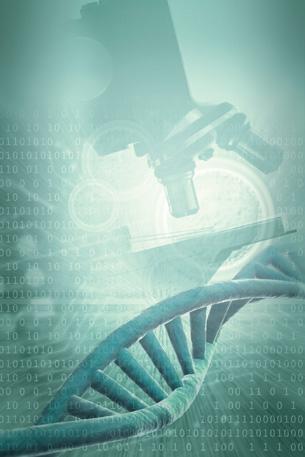Module 7
1. Module 7
1.4. Page 2
Module 7—Molecular Genetics: DNA, RNA, and Protein Synthesis
 Explore
Explore
 Read
Read

© 2008 Jupiterimages Corporation
Identifying the DNA as the molecule responsible for heredity took many years and the effort of many scientists. At the same time, other scientists were trying to determine the structure of DNA.
DNA, then known as “nucleic acid,” was first isolated from the nuclei of white blood cells by Friedrich Miescher in 1869. At this time, there was no connection made between this molecule and heredity. It took experiments by Phoebus Levene, Frederick Griffith, Alfred Hershey, and Martha Chase to finally prove that DNA was the molecule responsible for heredity. Before the connection to DNA was made, many scientists felt that protein, with all its possible forms, was the molecule responsible for the inheritance of so many traits and all the variations seen in living things.
While these scientists were looking for the agent of heredity, other scientists were studying the DNA molecule structure. Phoebus Levene first discovered that DNA was made up of chains of four different nucleotides: adenine (A), guanine (G), cytosine (C), and thymine (T). He also noted that RNA (ribonucleic acid, a molecule that you will study in Lesson 2) was also made up of four nucleotides, but that it had the base uracil (U) instead of thymine (T). Levene, unfortunately, incorrectly proposed that all nucleotides were found in the same concentration and in the same repeating order. This led scientists to believe that DNA couldn’t be the molecule of heredity. It seemed too simple to code for all the variation in living things.
Later, when Erwin Chargraff found that adenine (A) and thymine (T) are found in equal amounts in any sample of DNA, and cytosine and guanine were also found in equal amounts (but different to A and T), Levene’s hypothesis was disregarded and Chargaff’s rule of constant relationships between A and T, and C and G were accepted. Later still, the combination of Rosalind Franklin’s use of X-ray photography and the work of James Watson and Francis Crick produced the double helix structure model of the DNA molecule.
nucleotide: the repeating unit (monomer) of DNA; two strings of nucleotides joined in the middle by hydrogen bonds form a DNA molecule; each nucleotide is made up of a deoxyribose sugar, a nitrogenous base, and a phosphate group
adenine (A): a nitrogenous base of the purine group; complementary base pairs with thymine
guanine (G): a nitrogenous base of the purine group; complementary base pairs with cytosine
cytosine (C): a nitrogenous base of the pyrimidine group; complementary base pairs with guanine
thymine (T): nitrogenous base of the pyrimidine group; complementary base pairs with adenine
RNA: ribonucleic acid; a short, single strand composed of nucleotides with a nitrogen base, ribose sugar, and phosphate group; nitrogen bases include adenine, guanine, cytosine, and uracil; has a role in protein synthesis
uracil (U): a nitrogenous base found only in RNA, not DNA; replaces thymine when paired to adenine
Chargaff’s rule: in any sample of DNA, there is a constant relationship in which the amount of adenine is always approximately equal to the amount of thymine, and the amount of cytosine is always approximately equal to the amount of guanine
Watson and Crick: credited with co-discovery of the structure of DNA; received the Nobel Prize for their work
double helix: spiral ladder shape of the DNA molecule, made up of two long strands of nucleotides bound together and twisted
Learn more about the contributions of the above-mentioned scientists by reading pages 624 to “The Double Helix Structure of DNA,” on page 628. Summarize your readings by creating a timeline that includes scientists, experiments, and major discoveries that led to the identification of the hereditary agent and the structure of the DNA molecule. Place this timeline in your course folder for further reference when studying.
 Watch and Listen
Watch and Listen
Watch the animation of the “Hershey and Chase experiment” that proved the identity of the molecule controlling heredity. After watching this animation, you should be able to explain how this experiment proves that DNA, not protein, is the hereditary molecule. To view this animation, you may need a password from your teacher for the LearnAlberta website.
Watch the video “Introduction to Molecular Genetics: The Search for the Genetic Code.” The video also reviews the scientists and experiments that led to the discovery of DNA and its purpose and structure. This video supports the textbook reading of pages 624 to 628 that you just completed. Use the video to supplement your reading. You may need a password from your teacher to access the LearnAlberta website.
 Self-Check
Self-Check
SC 1. Complete this interactive activity “Scientists and Their Discoveries.” Make sure you complete all four activities. You will check your work as you complete the activity.
The Structure of DNA
It is essential that you master an understanding of the structure of DNA; therefore, complete both the following Watch and Listen and Read sections. Depending on your learning style, you may choose to do the video first, followed by the reading, or to do the reading followed by the video.
 Watch and Listen
Watch and Listen
deoxyribose sugar: a ring-shaped sugar; has one less oxygen than ribose sugar
phosphate: an inorganic phosphate group (PO43–)
nitrogen base: an organic molecule containing nitrogen; two types present in DNA: double-ringed purines (adenine and guanine) and single-ringed pyrimidines (cytosine and thymine)
Structurally, DNA is a three-dimensional molecule. Imagine a spiral staircase and you will understand the structure of DNA. For the details of DNA, watch the video “DNA Structure and Replication: Duplicating the Code.” Note the double helix shape and the arrangement of the deoxyribose sugars, phosphates, and nitrogen bases in the molecule. The relationship between DNA, chromosomes, and cells is also reviewed in the video. You will watch students perform a lab in which they extract and isolate DNA from calf thymus cells. When you get to “Replication of DNA,” stop the video. This topic will be covered in Lesson 2. You may need a password from your teacher in order to access the LearnAlberta website.
 Read
Read
complementary base pairs: refers to the hydrogen-bonded, nitrogenous base pairs of adenosine and thymine, and of cytosine and guanine in the DNA double helix
antiparallel: describes the property by which the 5’ to 3’ phosphate bridges run in opposite directions on each strand of nucleotides in a double-stranded DNA molecule
Many concepts in genetics are fundamental to the understanding of the structure of DNA. To be ready to apply your understanding of DNA structure to new situations in genetics, read “The Double Helix Structure of DNA” in your textbook on pages 628 to 629. Note Figure 18.6 on page 628 showing the arrangement of the deoxyribose sugars, phosphates, and nitrogen bases in the molecule. You should also note the definition of complementary base pairs, and the idea that the two strands of nucleotides in the double helix run antiparallel to each other. Adding a diagram that illustrates these features to your course folder would be an excellent idea.
 Try This
Try This
TR 1. Complete either Choice 1 or Choice 2.
Choice 1: Building DNA Gizmo
Use the “Building DNA Gizmo” to virtually build DNA molecules. Follow the steps outlined in the Exploration Guide to complete this activity. You may stop at the “DNA Replication” section, since this will be covered in Lesson 2. Be sure you are able to answer the questions in the guide as you move through each step. Contact your teacher if you have difficulties. If required, contact your teacher for the LearnAlberta password in order to access this gizmo.
Choice 2: Building DNA
For a more “hands-on” activity, you can build a DNA molecule from a paper template. This will allow for a more three-dimensional visual representation of the double helix. Based on the information from the video or your reading, or by doing a search on the Internet for ”DNA + model + paper template” to find your own model, build your own three-dimensional DNA. Keep your paper model, as you may use it in other lessons.
 Self-Check
Self-Check
SC 2. It is essential to understand the structure of DNA. To ensure your mastery, complete the DNA Self-Check.
 Module 7: Lesson 1 Assignment
Module 7: Lesson 1 Assignment
Retrieve the copy of the Module 7: Lesson 1 Assignment that you saved to your computer earlier in this lesson. Complete the assignment. Save your completed assignment in your course folder. You will receive instructions later in this lesson about when to submit your assignment to your teacher.
 Reflect on the Big Picture
Reflect on the Big Picture

© Paul Pantazescu/iStockphoto
It’s a bird, it’s a plane, no . . . it’s . . . it’s Superman! What made these heroes “super”? These superheroes had special powers above and beyond a regular human being. Based on your knowledge of DNA and mutations, is it possible for superheroes to really exist? Could Peter Parker really have been bitten by a radioactive spider and given his spider-like abilities? Could the Incredible Hulk really be created by exposing someone to gamma radiation? Could other, less obvious mutations occur?
The discovery of the structure of DNA in 1953 allowed scientists to begin understanding how hereditary information is passed from generation to generation. Knowing this structure allows scientists to explore the processes that can occur to change our hereditary information. Processes like mutations were examined at the molecular level.
The concept that mutations could cause strange superhuman effects was rarely found in the cartoon industry before the 1950s. Once DNA was discovered, more and more mutant superheroes were created. Research a superhero that developed her or his powers through some sort of mutation. Record the details of this superhero’s mutation—the how, when, why, what, and where of the mutation. Place this information in your course folder to be referred to in the next lesson.
 Module 7: Lesson 1 Assignment
Module 7: Lesson 1 Assignment
Submit your completed Module 7: Lesson 1 Assignment to your teacher for assessment.